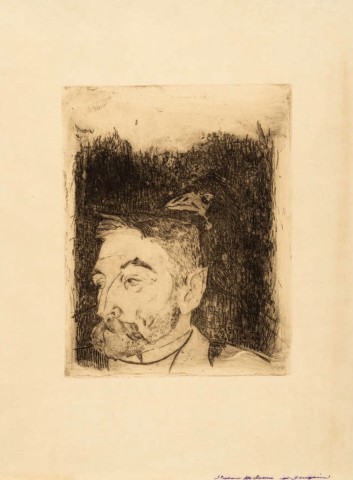Paul Gauguin
Mallarmé, 1891
Etching
0ne of 13 recorded trial proofs
on thin Japan paper
0ne of 13 recorded trial proofs
on thin Japan paper
310 x 229 mm
Copyright The Artist
This image, one of only two etchings by the artist, concisely represents the major figures and ideas that gave rise to the Symbolist school. Gauguin and the poet Mallarmé, who...
This image, one of only two etchings by the artist, concisely represents the major figures and ideas that gave rise to the Symbolist school. Gauguin and the poet Mallarmé, who met only a few months before this plate was completed, were to become lifelong friends and giants of the movement in their respective creative endeavors.
After being introduced by a mutual friend (the writer Charles Morice) in late 1890, Gauguin attended Mallarmé's weekly salon whenever possible. There, he also met the poet, critic, and painter Albert Aurier (to whom this impression is dedicated). This plate, which was completed in early 1891 as Gauguin made preparations to depart Paris for his first sojourn in Tahiti, was born of the creative kinship between these influential figures and was distributed by Gauguin to a handful of like-minded friends, including Morice, Jean Dolent, Daniel de Monfried, Charles Filiger, and, naturally, Mallarmé himself.
The raven behind the subject's head references Mallarmé's influential 1875 translation of the famous poem of the same name by Edgar Allan Poe, illustrated with five lithographs by Manet. Gauguin's rendering closely resembles the cover image (Head of a Raven in Profile, Harris 83a), thereby acknowledging the French poet's important role in disseminating Poe's important pre-symbolist work to an eager audience.
Aurier's essay 'Les isolés: Vincent van Gogh,' published in Mercure de France in 1890, sealed the reputations of both artist and writer. Van Gogh was moved to write Aurier and encouraged him to consider the work of his colleague Gauguin, emphasizing the elder artist's influence on his own development as a painter (the symbiotic nature of the two artists' creative development is evident in this plate). If not before, Aurier and Gauguin certainly met later that year through Mallarmé. This print followed a few months afterward, and Aurier's next influential essay, 'Le symbolisme en peinture -- Paul Gauguin,' was published in March of 1891. It was the first instance in which the Symbolist movement was named and given shape.
Created at the crux of few critical months shared between these three great minds (Aurier died prematurely of a typhus infection in October of 1892), this print is a rare and powerful representation of the nascent Symbolist movement.
Additional literature: Brettell, R., Cachin, F., Frèches-Thory, C., and Stuckey, C. The Art of Paul Gauguin. National Gallery of Art, Washington and The Art Institute of Chicago, 1988, 199 - 202.
After being introduced by a mutual friend (the writer Charles Morice) in late 1890, Gauguin attended Mallarmé's weekly salon whenever possible. There, he also met the poet, critic, and painter Albert Aurier (to whom this impression is dedicated). This plate, which was completed in early 1891 as Gauguin made preparations to depart Paris for his first sojourn in Tahiti, was born of the creative kinship between these influential figures and was distributed by Gauguin to a handful of like-minded friends, including Morice, Jean Dolent, Daniel de Monfried, Charles Filiger, and, naturally, Mallarmé himself.
The raven behind the subject's head references Mallarmé's influential 1875 translation of the famous poem of the same name by Edgar Allan Poe, illustrated with five lithographs by Manet. Gauguin's rendering closely resembles the cover image (Head of a Raven in Profile, Harris 83a), thereby acknowledging the French poet's important role in disseminating Poe's important pre-symbolist work to an eager audience.
Aurier's essay 'Les isolés: Vincent van Gogh,' published in Mercure de France in 1890, sealed the reputations of both artist and writer. Van Gogh was moved to write Aurier and encouraged him to consider the work of his colleague Gauguin, emphasizing the elder artist's influence on his own development as a painter (the symbiotic nature of the two artists' creative development is evident in this plate). If not before, Aurier and Gauguin certainly met later that year through Mallarmé. This print followed a few months afterward, and Aurier's next influential essay, 'Le symbolisme en peinture -- Paul Gauguin,' was published in March of 1891. It was the first instance in which the Symbolist movement was named and given shape.
Created at the crux of few critical months shared between these three great minds (Aurier died prematurely of a typhus infection in October of 1892), this print is a rare and powerful representation of the nascent Symbolist movement.
Additional literature: Brettell, R., Cachin, F., Frèches-Thory, C., and Stuckey, C. The Art of Paul Gauguin. National Gallery of Art, Washington and The Art Institute of Chicago, 1988, 199 - 202.
Provenance
Collections:
Paris, Bibliotheque d’Art et Archeologie, 2 copies
New York, Museum of Modern Art, 2 copies
Vienna, Albertina, 2 copies
Munich, Staatliche Graphische Sammlung
The Hague, Gemeente Museum
Rheims, Musee Saint-Denis
Middletown CT, Davidson Art Centre
London, British Museum
Literature
Mongan/Kornfeld/Joachim 12 11 BaPublications
E. Mongan, E.W. Kornfeld and H. Joachim, Paul Gauguin: Catalogue Raisonné of His Prints, Bern, 1988, pp. 40-45, no. 12 (another example illustrated).
